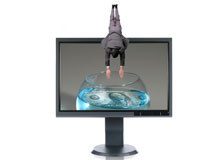Is Your “Open Floor” Showing Potential Customers the Open Door?

Currently, many dealerships operate using the open floor policy. Sales reps are queued up to take a new guest, make their own decision whether that customer is a buyer or not, and then either begin negotiations or drop the “looker” before turning to grab another potentially willing buyer. The best “burners” can do this in mere minutes. But think of the information that disappears each time this process unfolds. Did the rep acquire the customer’s name and a number? Was the prospect shown a car, and if so, which one? There are dozens of ways information is lost between the showroom floor and a dealer’s CRM system, but an open floor model is perhaps the biggest hole into which this information falls.
According to recent data, open floors cost the average dealership more than 12 percent in lost sales volume; meaning if a dealership is a 300 unit store, 35-40 deals per month are being lost. That’s thousands of dollars flowing out the door each month.
Today’s manager is asked to multi-task, and can’t possibly keep track of everything happening on the sales floor at the same time. The problem with an open floor model, however, is that it allows sales representatives to make costly decisions for your dealership. Without managing the process, it’s a sales rep, not a manager, making the decision on whether the prospect is worth spending additional time and effort on.
A mere 54 percent of the information collected from guests who walk onto dealership lots in the US actually make it into a CRM system. If you think your store closes at a 20 percent ratio, then take the number of retail sales and multiply them by five. That’s the number of guests that could, or should be, in your CRM.
So how do you solve the problem and ensure your sales representatives are giving every prospect the time and effort they deserve?
Change your process to a closed floor system
A few things happen when a store converts their showroom from an open floor to a closed floor. In a closed floor scenario, the sales representatives are put into an online queue and alerted when their turn on the floor is up. The remainder of sales rep’s time can be spent following up with prospects and creating lifetime value for each customer.
- The first benefit is a consistent, equal approach to how traffic is handled. When reps are placed in a consistent, fair rotation they can schedule their day more effectively.
- Secondly, with a closed floor system, follow-up becomes just as important as the sale. If a salesperson is at the bottom of the rotation, they have confidence that they have the time to follow up with prospects versus missing out on the next up who walks in the door.
- Third, a closed system enables managers to better determine the success of their sales reps. Maybe one of the less aggressive sales reps has the best closing ratios and just needs more opportunities to sit at the top of the sales board. With a closed system, a manager doesn’t know if the sales rep sold 15 units because he talked to 100 guests or because he better managed 50.
- In addition, a closed floor system provides an immediate increase in the perceived value of a customer. When a salesperson knows they will cycle to the bottom of the rotation by dropping a guest, they will treat that opportunity differently and are more likely to follow the proper steps to close a sale.
By changing your floor to a closed system, sales reps know that they won’t be able to burn through showroom traffic and instead depend on follow-up and cultivating the business they do have to sell more vehicles. The result is not only more names and numbers in the CRM system, but more sales in your showroom.
Clint Burns is the Founder of TheNextUp, www.thenextup.com. You can reach him at cburns@dealermark.com.
authored by
Michael Bowen
Get Curated Insights
Content worth the click
Related Articles













